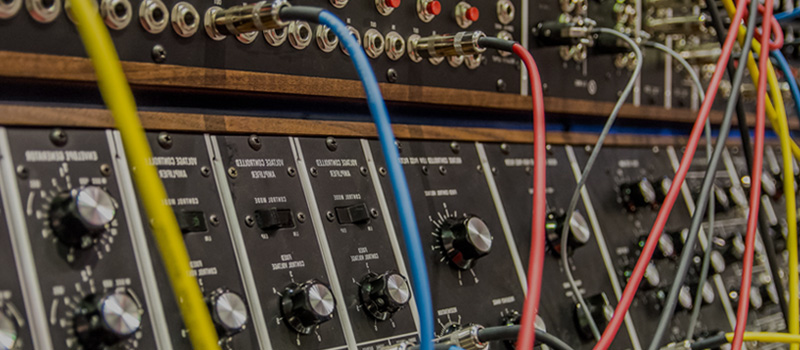The Glossary of Pro Audio Tech
There is a lot of technical terms in audio technology that often makes people feel confused. To help, we've made a collection of A-Z audio tech glossary which are meant to clarify what some of the audio terminologies mean. Bookmark this guide, and you can come to check it out once you come across a word that doesn't understand.

A
Active Speaker – Simply speaking, an active speaker is the one that has its amplifier built into the cabinet.
A/D converter (ADC) - Stands for Analog-to-digital converter, a device that transforms incoming analog signals into digital form.
Amplifier – An electronic device that increases the amplitude of its input signal, and produces a stronger amplitude signal at its output.
Amplitude – The relative magnitude of a signal in a single period.
Attenuation – The reduction in the strength of an electrical signal.
Audio Frequency – The acoustic spectrum of human hearing, typically regarded to be 20 to 20,000 Hz.
B
Baffle – The baffle means a board or other planar surface in the front part of a speaker, which is used to prevent sound waves from entering or leaving a space.
Bandwidth – The range of frequencies passed by an amplifier or transducer.
Bass – In audio engineering, the bass refers to the low range of audio frequencies up to approximately 250 Hz.
Boom – A telescoping support arm attached to a microphone stand holding the mic.
Bus – A bus is a pathway along which an electrical signal flows.
C
Channel – Similar to a bus, a functional path through an audio device.
Class A Amplifier – It is the most common type as they use just one output switching transistor within their amplifier design. The Class A amplifier is large and heavy, which produces very low distortion and is mostly found in high-end equipment.
Class B Amplifier – A class B amplifier circuit differs from Class A. It consists of two active devices that conduct half of the actual cycle. Two devices provide a combined current drive for the load.
Class AB Amplifier – Class AB amplifiers combine Class A and Class B to realize an amplifier with more efficiency than Class A but with lower distortion than class B.
Class D amplifier – The Class D amplifier is a different type known as a switching amplifier that uses Pulse Width Modulation or PWM. It can be much more compact and lightweight than conventional amps because they don't require robust power supplies or heat sinks.
Crossover – A crossover is like a boss assigning work to the right person. It is something inside going to tell what each speaker needs to handle.
D
D/A Converter (DAC) - Digital-to-analog converter, a device that transforms incoming digital signals into analog form.
Decibel (dB) – Logarithmic measurement of signal strength. A ratio of 1000:1=60 dB.
DSP – A Digital Signal Processing (DSP) is a specialized microprocessor chip. It takes real-world signals like voice, audio, pressure, or position that are digitized and then mathematically manipulate them.
Driver – The component in a loudspeaker that physically creates sound.
E
Equalization (EQ) – The process of changing the audio frequencies to correct or enhance the sound.
F
Fader – A type of audio level control. Today it refers to a straight-line slide control instead of rotating.
Frequency – It indicates the number of times cycles of a repetitive waveform occurs during one second.
G
Gain – It stands for the number of decibels a signal is amplified by in comparison to the strength of the initial signal.
Gate – A dynamics device that automatically turns off an input signal when it drops below a certain level. Often called a noise gate.
H
Hertz (Hz) – A unit of frequency, cycles per second.
I
Impedance – The quantity of opposition a device has got to an audio signal. In technical terms, the combined effect of capacitance, inductance, and resistance on a signal.
Interface – A device that serves as a bridge between two or more pieces of audio equipment.
J
Jack (Plug) – An audio connector, typically 0.25 inches in diameter.
L
Latency – It is the parameter expressing the extent of the delay effect.
M
MIDI – Musical Instrument Digital Interface, the standard serial communication protocol for the interface and control of musical instruments.
Mixer – A device takes two or more audio signals and mixes them down to a single mono or stereo signal.
O
Ohm – A unit of electrical resistance.
P
PA System – Short for Public Address System, which is an electronic amplification system used as a communication system in public areas.
Passive Speaker – Opposite to the Active speaker, it draws power from an external amp and is connected to that amp through speaker wire.
Peak – The very best level of strength of an audio signal. When a signal peaks beyond what a circuit can handle, it distorts.
R
RCA – A common type of audio/video connector.
Reverb – The effect of sound waves bouncing off walls and other objects.
S
Stereo – Audio that is made up of left and right channels.
SPL – Short for Sound Pressure Level, a standard measure the acoustic volume or loudness of sound.
T
TRS – Acronym for Tip-Ring-Sleeve, the three parts of a two-conductor phone plug.
Transducer – It refers to a device that converts energy from one form to another.
V
Voltage – Voltage is the rate at which energy is drawn from a source that produces a flow of electricity in a circuit.
W
Watt – A metric unit of power defined as one Joule per second.
X
XLR – A lockable audio connector, available with various numbers of pins.